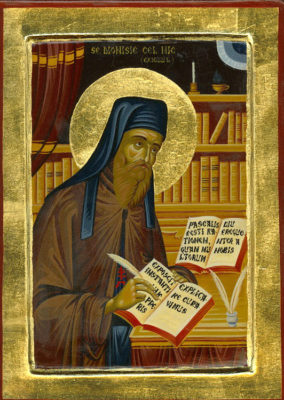Related Research Articles

Bede, also known as Saint Bede, The Venerable Bede, and Bede the Venerable, was an English monk and an author and scholar. He was one of the greatest teachers and writers during the Early Middle Ages, and his most famous work, Ecclesiastical History of the English People, gained him the title "The Father of English History". He served at the monastery of St Peter and its companion monastery of St Paul in the Kingdom of Northumbria of the Angles.

Easter, also called Pascha or Resurrection Sunday, is a Christian festival and cultural holiday commemorating the resurrection of Jesus from the dead, described in the New Testament as having occurred on the third day of his burial following his crucifixion by the Romans at Calvary c. 30 AD. It is the culmination of the Passion of Jesus Christ, preceded by Lent, a 40-day period of fasting, prayer, and penance.

The Metonic cycle or enneadecaeteris is a period of almost exactly 19 years after which the lunar phases recur at the same time of the year. The recurrence is not perfect, and by precise observation the Metonic cycle defined as 235 synodic months is just 2 hours, 4 minutes and 58 seconds longer than 19 tropical years. Meton of Athens, in the 5th century BC, judged the cycle to be a whole number of days, 6,940. Using these whole numbers facilitates the construction of a lunisolar calendar.

Celtic Christianity is a form of Christianity that was common, or held to be common, across the Celtic-speaking world during the Early Middle Ages. Some writers have described a distinct Celtic Church uniting the Celtic peoples and distinguishing them from adherents of the Roman Church, while others classify Celtic Christianity as a set of distinctive practices occurring in those areas. Varying scholars reject the former notion, but note that there were certain traditions and practices present in both the Irish and British churches that were not seen in the wider Christian world.
The Synod of Whitby was a Christian administrative gathering held in Northumbria in 664, wherein King Oswiu ruled that his kingdom would calculate Easter and observe the monastic tonsure according to the customs of Rome rather than the customs practiced by Irish monks at Iona and its satellite institutions. The synod was summoned at Hilda's double monastery of Streonshalh (Streanæshalch), later called Whitby Abbey.

Dionysius Exiguus was a 6th-century Eastern Roman monk born in Scythia Minor. He was a member of a community of Scythian monks concentrated in Tomis, the major city of Scythia Minor. Dionysius is best known as the inventor of Anno Domini (AD) dating, which is used to number the years of both the Gregorian calendar and the (Christianised) Julian calendar. Almost all churches adopted his computus for the dates of Easter.

As a moveable feast, the date of Easter is determined in each year through a calculation known as computus. Easter is celebrated on the first Sunday after the Paschal full moon, which is the first full moon on or after 21 March. Determining this date in advance requires a correlation between the lunar months and the solar year, while also accounting for the month, date, and weekday of the Julian or Gregorian calendar. The complexity of the algorithm arises because of the desire to associate the date of Easter with the date of the Jewish feast of Passover which, Christians believe, is when Jesus was crucified.
The epact used to be described by medieval computists as the age of a phase of the Moon in days on 22 March; in the newer Gregorian calendar, however, the epact is reckoned as the age of the ecclesiastical moon on 1 January. Its principal use is in determining the date of Easter by computistical methods. It varies from year to year, because of the difference between the solar year of 365–366 days and the lunar year of 354–355 days.
Theophilus was the 23rd Pope of Alexandria and Patriarch of the Seat of Saint Mark. He became pope at a time of conflict between the newly dominant Christians and the pagan establishment in Alexandria, each of which was supported by a segment of the Alexandrian populace.
Annianus of Alexandria was a monk and writer who flourished in Alexandria during the pontificate of Theophilus I around the beginning of the 5th century.

The Martyrologium Hieronymianum or Martyrologium sancti Hieronymi is an ancient martyrology or list of Christian martyrs in calendar order, one of the most used and influential of the Middle Ages. It is the oldest surviving general or "universal" martyrology, and the precursor of all later Western martyrologies.
The controversy over the correct date for Easter began in Early Christianity as early as the 2nd century AD. Discussion and disagreement over the best method of computing the date of Easter Sunday has been ongoing ever since and remains unresolved. Different Christian denominations continue to celebrate Easter on different dates, with Eastern and Western Christian churches being a notable example.
Victorius of Aquitaine, a countryman of Prosper of Aquitaine and also working in Rome, produced in AD 457 an Easter Cycle, which was based on the consular list provided by Prosper's Chronicle. This dependency caused scholars to think that Prosper had been working on his own Easter Annals for quite some time. In fact, Victorius published his work only two years after the final publication of Prosper's Chronicle.
Anatolius of Laodicea, also known as Anatolius of Alexandria, was a Syro-Egyptian saint and Bishop of Laodicea on the Mediterranean coast of Roman Syria in AD 268. He was not only one of the foremost scholars of his day in the physical sciences, as well as in Aristotelian and Platonic philosophies, but also a renowned computist and teacher of the Neoplatonic philosopher Iamblichus.
The Reckoning of Time is an English era treatise written in Medieval Latin by the Northumbrian monk Bede in 725.
The Sardica paschal table or Sardica document is a document from a Latin manuscript of the 7th/8th century AD. It is a copy in Latin translation of the creed of the Eastern Christian bishops attending the Council of Sardica who, fearing that their deliberations would be dominated by Western bishops, met separately at Philippopolis. Appended to the creed and anathemas is a table of Paschal full moon dates, given as dates in the Julian calendar, for the years 328 to 357, together with a list of dates of 14 Nisan in the Jewish calendar, also referred to the Julian calendar, for the years 328 to 343, the year of the Council. The calendrical information contained in the document has been used by scholars in tracing the history of the computus and of the Hebrew calendar.
A laterculus was, in late antiquity or the early medieval period, an inscribed tile, stone or terracotta tablet used for publishing certain kinds of information in list or calendar form. The term thus came to be used for the content represented by such an inscription, most often a list, register, or table, regardless of the medium in which it was published. A list of soldiers in a Roman military unit, such as of those recruited or discharged in a given year, may be called a laterculus, an example of which is found in an inscription from Vindonissa. The equivalent Greek term is plinthos.
Polemius Silvius was the author of an annotated Julian calendar that attempted to integrate the traditional Roman festival cycle with the new Christian holy days. His calendar, also referred to as a laterculus or fasti, dates to around 448–449. He was active in southeastern Gaul.

A computus clock is a clock equipped with a mechanism that automatically calculates and displays, or helps determine, the date of Easter. A computus watch carries out the same function.
References
- ↑ Louis Duchesne, Fastes épiscopaux de l'ancienne Gaule: Provinces du Sud-est (Paris, 1984), vol. 1, pp. 19 online, 250, 269, 349, citing the Latin sources.
- ↑ Christine Barnel, "Town and Country in Provence: Toulon, Its Notaries, and Their Clients," in Urban and Rural Communities in Medieval France: Provence and Languedoc, 1000–1500 (Brill, 1998), p. 240 online.
- ↑ Auguste Allmer, Revue épigraphique du Midi de la France 2 (1884–1889), pp. 374–375 online.
- ↑ Duchesne, Fastes épiscopaux, p. 250.
- ↑ Martyrologium Hieronymianum VII id. sept., as cited by S.T. Loseby, "Bishops and Cathedrals: Order and Density in the Fifth-Century Urban Landscape of Southern Gaul," in Fifth-Century Gaul: A Crisis of Identity (Cambridge University Press, 1992), p. 147 online.
- ↑ Martyrologium romanum Gregorii XIII, Pontificis Maximi. Urbani VIII et Clementis Papae X auctoritate recognitum (1807).
- ↑ St. Leo the Great: Letters, translated by Edmund Hunt (Fathers of the Church, 1957), pp. 120–121 and 134–135. See also Jacques Paul Migne, Flavii Lucii Dextri Chronicon in Patrologiae latina cursus completus (Paris, 1846), vol. 31, 507/508 online, especially note 7.
- ↑ For the scholarly debate on his date, see Alden A. Mosshammer, The Easter Computus and the Origins of the Christian Era (Oxford University Press), pp. 217 and 227–228.
- ↑ For the Latin text of which see Bruno Krusch, Studien zur christlich-mittelalterlichen Chronologie. Der 84jährige Ostercyclus und seine Quellen (Leipzig, 1880), reference to Augustalis p. 280 online.
- ↑ Bibl. Cap. 490. The text of the Carthaginian Computus was first published in 1761 by Giovan Domenico Mansi.
- ↑ Mosshammer, The Easter Computus, p. 219.
- ↑ Mosshammer, The Easter Computus, p. 228.
- ↑ In the inclusive counting of ancient Rome. See Faith Wallis, Bede: The Reckoning of Time (Liverpool University Press, 1999), p. xiv online.
- ↑ Mosshammer, The Easter Computus, pp. 217, 220, 225–228.
- ↑ Wallis, Bede, p. xiv. For an explanation of saltus and its usage by scholars in the context of the epact, see Mosshammer, The Easter Computus, pp. 75–76 online.
- ↑ Sanctissimae memoriae Augustalis.
- ↑ Mosshammer, The Easter Computus, p. 218.
- ↑ This dating would exclude the possibility that the De ratione author was the same man as the bishop of Toulon or the Augustalis whose saint's day was September 7.
- ↑ Mosshammer reproduces the table pp. 210–211.
- ↑ Krusch as summarized by Mosshammer, The Easter Computus, pp. 208–209, 217. Although Mansi had published the Carthaginian Computus in the 18th century, it had gone mostly unnoticed by scholars until Krusch's republication in 1880.
- ↑ On the vexed identity of this Hippolytus, see Mosshammer, "The Hippolytan Problem," in The Easter Computus pp. 118–121 et passim .
- ↑ Wallis, Bede, p. xiv; Mosshammer, The Easter Computus, p. 222.
- ↑ On which see also Mosshammer, The Easter Computus, pp. 229–231.